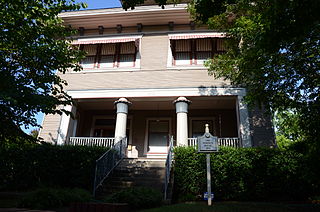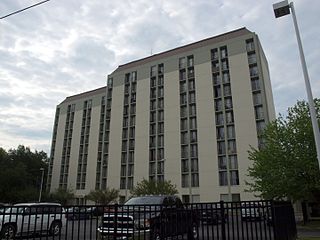The Quapaw Quarter of Little Rock, Arkansas, is a section of the city including its oldest and most historic business and residential neighborhoods. The area's name was first given in 1961, honoring the Quapaw Indians who lived in the area centuries ago.

Hillcrest Historic District is a historic neighborhood in Little Rock, Arkansas that was listed on the National Register of Historic Places on December 18, 1990. It is often referred to as Hillcrest by the people who live there, although the district's boundaries actually encompass several neighborhood additions that were once part of the incorporated town of Pulaski Heights. The town of Pulaski Heights was annexed to the city of Little Rock in 1916. The Hillcrest Residents Association uses the tagline "Heart of Little Rock" because the area is located almost directly in the center of the city and was the first street car suburb in Little Rock and among the first of neighborhoods in Arkansas.

The Fordyce House is a historic house at 2115 South Broadway in Little Rock, Arkansas. Built in 1904 to a design by noted Arkansas architect Charles L. Thompson, it is believed to be the state's only example of Egyptian Revival residential design. It is two stories in height, with narrow clapboard trim. A recessed porch shelters the main entrance, with the stairs leading up to flanked at the top by two heavy Egyptian columns. The second floor windows are banded in groups of three and the roof has a deep cornice with curved brackets. John Fordyce, for whom it was built, was a prominent businessman and engineer who held numerous patents related to cotton-processing machinery.

The Governor's Mansion Historic District is a historic district covering a large historic neighborhood of Little Rock, Arkansas. It was listed on the National Register of Historic Places in 1978 and its borders were increased in 1988 and again in 2002. The district is notable for the large number of well-preserved late 19th and early 20th-century houses, and includes a major cross-section of residential architecture designed by the noted Little Rock architect Charles L. Thompson. It is the oldest city neighborhood to retain its residential character.

John Parks Almand was an American architect who practiced in Arkansas from 1912 to 1962. Among other works, he designed the Art Deco Hot Springs Medical Arts Building, which was the tallest building in Arkansas from 1930 to 1958. Several of his works, including the Medical Arts Building and Little Rock Central High School, are listed on the National Register of Historic Places.

St. Edwards Church is a historic Roman Catholic church at 801 Sherman Street in Little Rock, Arkansas, United States. Built in 1901, it is a handsome Gothic Revival structure, built out of brick with stone trim. A pair of buttressed towers flank a central gabled section, with entrance in each of the three parts set in Gothic-arched openings. A large rose window stands above the center entrance below the gable, where there is a narrow Gothic-arched louver. Designed by Charles L. Thompson, it is the most academically formal example of the Gothic Revival in his portfolio of work.

The Baker House is a historic house at 501 Main Street in North Little Rock, Arkansas, United States. It is an L-shaped structure, 2½ stories in height, with a three-story round tower at the crook of the L. A highly decorated porch is built around the tower, providing access to the entrance. Built in 1898–99, it is one of the few surviving high-style Queen Anne Victorians in the city. It was built by A. E. Colburn, a local contractor, as his private residence, and was purchased in 1916 by C. J. and Annie Baker. Baker was from 1904 to 1906 the superintendent of North Little Rock's schools.

The Julian Bunn Davidson House is a historic house at 410 South Battery Street in Little Rock, Arkansas. It is the only formerly residential structure in Arkansas capitol district, currently housing state offices. It is a single-story Mid-Century Modern structure, designed by local architect Julian Bunn Davidson for his family and built in 1951. It is a high-quality example of the modern style, and the only one in this region of the city.

The Harris House is a historic house at 6507 Fourche Dam Pike in Little Rock, Arkansas. It is a single-story stuccoed structure, designed in an ecelctic interpretation of Spanish Revival architecture. Prominent features include a circular tower at one corner, a parapet obscuring its sloping flat roof, and a port-cochere with a segmented-arch opening supported by battered wooden columns. It was built in 1924 for Florence and Porter Field Harris, to their design and probably the work of Porter Harris, a master plasterer known for his work on the Arkansas State Capitol.

The MacArthur Park Historic District encompasses a remarkably well-preserved collection of Victorian buildings in the heart of Little Rock, Arkansas. The main focal point of the district is MacArthur Park, site of the Tower Building of the Little Rock Arsenal and Little Rock's 19th-century military arsenal. The district extends north and west from the park for about four blocks, to East Capitol Avenue in the north and Scott Street to the west, and extends south, beyond Interstate 630, to East 17th Street. This area contains some of the city's finest surviving antebellum and late Victorian architecture, including an particularly large number (19) of Second Empire houses, and achieved its present form roughly by the 1880s. The MacArthur Park Historic District was listed on the National Register of Historic Places in 1977.

The Memorial to Company A, Capitol Guards is an American Civil War memorial in MacArthur Park, Little Rock, Arkansas. It stands just northeast of the former Tower Building of the Little Rock Arsenal, at a junction of two of the park's internal roadways. It consists of a bronze sculpture depicting a Confederate Army soldier in a defensive stance, holding a rifle pointed forward. The statue is 8 feet (2.4 m) in height, and is mounted in a granite column 16 feet (4.9 m) tall. The memorial is sometimes known as "Lest we forget", a line appearing near the top of the inscription on the base. The statue was created by sculptor Rudolph Schwarz, and was installed in 1911; it was paid for by the local chapter of the Sons of Confederate Veterans, and memorializes the unit that seized the arsenal at the outset of the war.

The Park Hill Historic District encompasses the first suburban residential subdivision of the city of North Little Rock, Arkansas. It covers 172 acres (70 ha) in a geographically central part of the city, bisected by JFK Boulevard, and roughly bounded on the north by H Avenue, the west by Ridge Road, the east by Cedar Street and Plainview Circle, and the south by Crestview Drive. This area was developed beginning in 1922 by Justin Matthews, a major local developer, and greatly expanded the city's housing stock through the 1940s and 1950s. The vast majority of its architecture is residential, with commercial development limited to its major arterial roadways. The district includes Crestview Park and the Park Hill Fire Station and Water Company Complex.

The South Main Street Apartments Historic District encompasses a pair of identical Colonial Revival apartment houses at 2209 and 2213 Main Street in Little Rock, Arkansas. Both are two-story four-unit buildings, finished in a brick veneer and topped by a dormered hip roof. They were built in 1941, and are among the first buildings in the city to be built with funding assistance from the Federal Housing Administration. They were designed by the Little Rock firm of Bruggeman, Swaim & Allen.

The South Main Street Residential Historic District encompasses a residential area south of downtown Little Rock, Arkansas. The area, extending along South Main Street roughly between 19th and 23rd Streets, was developed between about 1880 and 1945, and includes a well-preserved set of residential architecture from that period. Notable buildings include the Luxor Apartments, the Holcomb Court Apartments, and the Ada Thompson Memorial Home.

The Dan Stowers Office Building is a historic commercial building at 1516 West 3rd Street in Little Rock, Arkansas. It is a single-story masonry structure, with an International style design by architect Dan Stowers, Sr. It was built in 1961, and served as the office of Stowers and his son, Dan Jr., until 2013. The building is notable for its Mid-Century Modern design, featuring curtain-wall windows, porcelain enamel panels, and blocks of haydite in its construction.

The Terminal Hotel is a historic commercial building at Victory and Markham Streets in Little Rock, Arkansas. It is a three-story Classical Revival brick building, set across Victory Street from Little Rock Union Station. It was built in 1905 as a railroad hotel, and has since been converted into residential housing units.

The Tower Building is a commercial eighteen-story skyscraper at 323 Center Street in downtown Little Rock, Arkansas. Built in 1959–60, it was the tallest building in the state at the time of its completion, and the state's first instance of composite steel frame construction. It was designed by Little Rock architect F. Eugene Withrow and Dallas, Texas architect Harold A. Berry in the International style. It has curtain walls of windows on its north and south facades, and blank brick walls on the east and west, with the elevator tower projecting from its southern facade.

Trinity Hospital is a historic former hospital, now a mixed-used commercial and residential building, at 20th and Main Streets in Little Rock, Arkansas. It is a two-story brick structure, roughly square in shape with a central courtyard and an ell projecting from its southern side. It was designed by local architect Maximilian F. Mayer and built in 1924, with restrained Classical Revival elements. The building is historically notable as the first place in Arkansas where the now-common health maintenance organization methods of funding and delivering health care were implemented. The building now houses the offices of a non-profit and low-income housing.

The Cumberland Towers are a residential apartment highrise at 311 East 8th Street in Little Rock, Arkansas. Built in 1974, it is an eleven-story skyscraper, with a steel frame clad in stuccoed brick, housing 178 residential units. It was designed by Wittenberg, Delony & Davidson for the city as public senior housing, it exemplifies a design principle espoused by Le Corbusier known as the "tower in a park", with a large landscaped green area surrounding the building.

The Fred W. Parris Towers are a residential apartment highrise at 1800 South Broadway Street in Little Rock, Arkansas. Built in 1972, it is a fourteen-story skyscraper, with a steel frame clad in masonry, housing 250 residential units. It was designed by Wittenberg, Delony & Davidson for the city as public senior housing, and exemplifies a design principle espoused by Le Corbusier known as the "tower in a park", with a large landscaped green area surrounding the building.



















